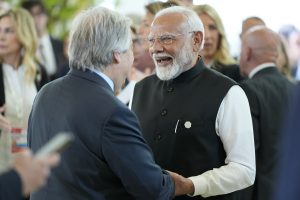On June 8, 2024, Narendra Modi etched his name in the annals of Indian history, surpassing all previous non-Congress prime ministers to become the longest-serving leader in this category. This feat stands as a testament to his grip on the Indian political landscape and his commanding influence over the nation’s domestic affairs.
However, as Modi assumes the role of India’s figurehead for the next five years, the future trajectory of India’s foreign policy demands a thorough and multifaceted examination that goes beyond the veneer of his political longevity.
Modi’s victory also demands a careful analysis of how his domestic politics, rhetoric, and success have affected – and will affect – his foreign policy and India’s standing on the world stage.
Provincial to Premier
For one, Modi’s accomplishment of winning a third term – and, immediately after that, being invited to the G-7 summit as an observer – is a testament to his journey from a once-dismissed “provincial leader” and “regional satrap” to a statesman with a commanding presence on the international stage.
A decade ago, few could have predicted that the man whose brand of Hindutva politics and strongman image drew scorn from domestic opponents, Western governments, and global political pundits would one day be hailed as a premier statesman. The 2002 Gujarat riots, which occurred under Modi’s watch as chief minister, led to significant international isolation, with the United States and other Western nations denying him a visa. However, Modi’s resounding victory in the 2014 general elections compelled a swift reversal in U.S. policy, as Washington pragmatically engaged with India’s new leader.
Fast forward to the present, and the very countries and leaders who once criticized Modi during his Gujarat days now acknowledge his indispensable role in navigating complex global issues. Ironically, it was Modi’s tenure as chief minister of Gujarat from 2001 to 2014, marked by his strongman image, that laid the groundwork for his ascent, placing him in the company of assertive leaders like Recep Tayyip Erdogan, Xi Jinping, Sheikh Hasina, Vladimir Putin, and Mohammed bin Salman.
With India’s rapidly sinking position in democracy, press, religious freedom, and other similar indices, it is only right that Modi is seen as one in the pantheon of illiberal leaders in stark contrast to the liberal democracies of the West. And this despite India never losing an opportunity to call itself “the world’s largest democracy.”
Modi’s hallmark approach, which prioritizes economic development, infrastructure projects, and foreign investment over social justice and inclusivity, can be traced back to his time in Gujarat. In the face of the backlash over the 2002 riots, Modi focused on initiatives like the “Vibrant Gujarat” summits, a strategy that remains central to his political playbook as prime minister.

































